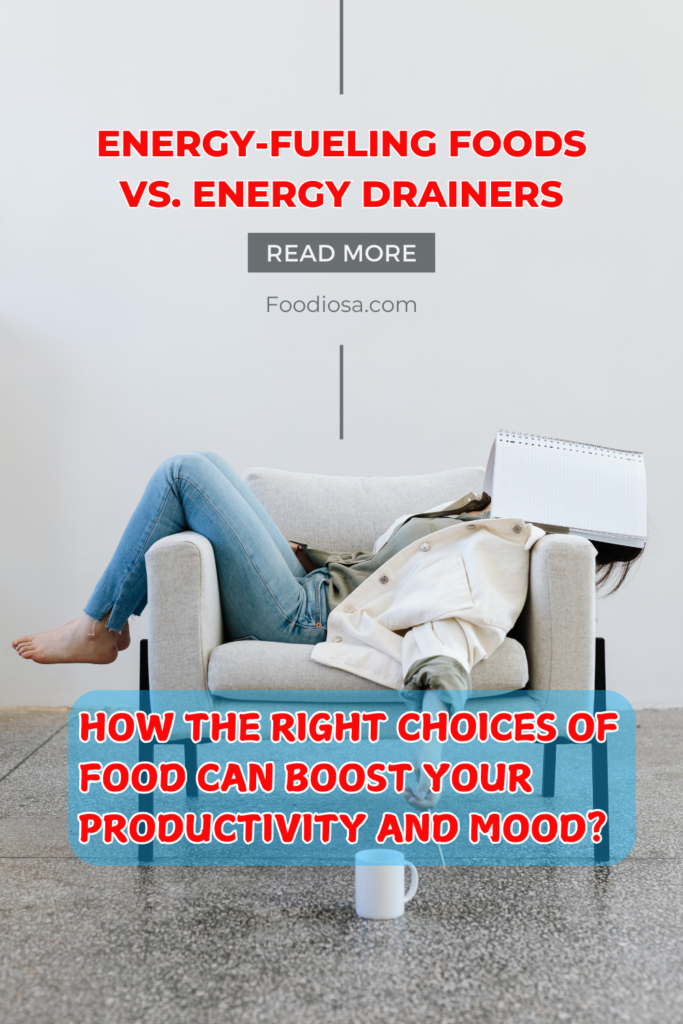We’ve all experienced that mid-afternoon slump where our energy dips, and we find ourselves reaching for a sugary snack or an extra cup of coffee.
But what if we could optimize our food choices to fuel our bodies with sustained energy throughout the day?
In this article, we’ll explore the differences between energy fueling foods and energy drainers, and how the right choices can boost your productivity and mood.
Let’s dive into how you can make smarter decisions for your daily energy needs!
Understanding Energy in Food
What is Energy from Food?
At its core, the food we eat is converted into energy by our bodies.
This process involves breaking down carbohydrates, fats, and proteins into molecules like glucose, which our cells use as fuel.
Different foods provide varying amounts and types of energy, affecting how we feel and perform throughout the day.
How Our Body Uses Food for Energy
When we eat, our digestive system breaks down food into nutrients, which are absorbed into the bloodstream and transported to cells.
The body primarily uses glucose for energy, but it also draws from fat and protein stores when needed.
The rate at which these energy sources are released can impact how we feel in terms of alertness and fatigue.

What are the Energy-Fueling Foods?
Definition of Energy-Fueling Foods
Energy-fueling foods are nutrient-dense options that provide long-lasting energy.
These foods are rich in complex carbohydrates, proteins, healthy fats, vitamins, and minerals.
They help maintain stable blood sugar levels and provide steady energy throughout the day, preventing crashes and sluggishness.
Benefits of Energy-Fueling Foods
These foods help improve mental clarity, enhance physical performance, stabilize mood, and prevent fatigue.
By choosing nutrient-rich foods, you are giving your body the tools it needs to stay energized and focused without resorting to short-term fixes like sugary snacks.
Examples of Energy-Fueling Foods
Here are some examples of foods that can boost your energy:
- Whole Grains: Brown rice, oats, quinoa, and barley provide complex carbs that release energy slowly.
- Fresh Fruits and Vegetables: Bananas, avocados, leafy greens, and berries offer natural sugars, fiber, and essential vitamins.
- Nuts and Seeds: Almonds, chia seeds, walnuts, and flaxseeds are packed with healthy fats and protein.
- Lean Proteins: Chicken, turkey, tofu, and beans provide amino acids that support muscle function and energy.
- Healthy Fats: Olive oil, fatty fish, and nut butters are sources of healthy fats that help maintain energy levels.

How These Foods Help Sustain Energy
Unlike processed foods, which cause energy spikes and crashes, energy-fueling foods release energy gradually, providing you with consistent levels of alertness throughout the day.
They also help regulate blood sugar levels, reducing the likelihood of feeling fatigued or irritable.
Characteristics of Energy-Fueling Foods
Energy-fueling foods share several key characteristics:
- Nutrient-Dense: These foods are packed with essential nutrients without excess empty calories.
- Rich in Complex Carbs, Proteins, and Healthy Fats: These macronutrients are crucial for long-lasting energy.
- High in Vitamins and Minerals: Nutrients like B-vitamins, iron, magnesium, and potassium are vital for energy metabolism.

Energy Drainers: What Are They?
Definition of Energy Draining Foods
Energy drainers are foods and beverages that can lead to quick bursts of energy followed by crashes, leaving you feeling tired, sluggish, and less focused.
These foods typically have a high glycemic index or are highly processed, causing rapid spikes and drops in blood sugar levels.
Effects of Energy Drainers on the Body
When consumed in excess, energy-draining foods can lead to fatigue, irritability, and even cravings for more sugar or caffeine.
Over time, regularly eating these foods can contribute to weight gain and poor overall health.
How They Affect Your Mood and Productivity
The sugar crashes caused by energy-draining foods can make you feel sluggish, irritable, and mentally foggy.
This can negatively impact your work performance, concentration, and general mood.

Characteristics of Energy Draining Foods
Energy-draining foods are often:
- High in Sugar: Foods and drinks high in added sugars cause rapid blood sugar spikes.
- Processed and Refined Carbs: Foods like white bread and pasta are quickly broken down into glucose, leading to energy crashes.
- Lacking Essential Nutrients: These foods often offer little nutritional value beyond empty calories.

Top Energy Draining Foods
Here are some common energy-draining foods:
- Sugary Drinks: Sodas, energy drinks, and sweetened coffees provide a quick sugar rush but lead to crashes later.
- Processed Snacks: Chips, cookies, and candy are often loaded with sugar and unhealthy fats.
- Refined Grains: White bread, pasta, and pastries are rapidly digested, causing blood sugar spikes.
- Fried Foods and Fast Food: These foods are typically high in unhealthy fats, which can make you feel sluggish.
How Energy Drainers Affect Mental and Physical Health
Energy-draining foods can take a toll on both your mind and body.
They can lead to a dip in mood, decreased concentration, and reduced physical performance.
Over time, they may also contribute to chronic fatigue and sleep disturbances.
How to Balance Energy-Fueling Foods and Energy Drainers?
Strategies for Incorporating Energy-Fueling Foods
Try to focus on balanced meals that combine healthy fats, proteins, and complex carbs. This will help you feel energized for longer periods.
Reducing the Intake of Energy Drainers
Limit processed foods, sugary snacks, and fried foods. Instead, opt for whole, natural foods that provide lasting energy.
Tips for Sustainable Energy Throughout the Day
Eat smaller meals more frequently to avoid large spikes in blood sugar. Avoid skipping meals, as it can lead to energy crashes later.
The Role of Hydration in Maintaining Energy Levels:
Drinking enough water is essential for maintaining your energy.
Dehydration can lead to fatigue, poor concentration, and irritability.

Practical Tips for Eating for Energy:
Meal Timing and Frequency
Eating regular, balanced meals every 3-4 hours can help keep your energy levels steady.

Healthy Snack Options
Choose snacks like fruit, nuts, or yogurt for a quick energy boost without the crash.
Portion Control
Overeating can lead to sluggishness. Pay attention to portion sizes to avoid overloading your body.
Debunking Common Myths About Energy and Food
Myth #1: Sugar Gives You Instant Energy
While sugar can provide a quick rush, it’s followed by a rapid drop in blood sugar, leading to a crash.
Myth #2: Carbs are Bad for Energy Levels
Not all carbs are created equal. Complex carbs from whole grains provide steady, long-lasting energy.
Conclusion
To keep your energy levels up throughout the day, focus on consuming nutrient-dense, whole foods while limiting your intake of processed snacks and sugary drinks.
By balancing your meals and staying hydrated, you can fuel your body for optimal performance, mood, and focus.
Remember, the right foods can make all the difference in how you feel!
FAQs
- What are the best foods for sustained energy?
- Whole grains, lean proteins, healthy fats, and fresh fruits and vegetables are excellent sources of sustained energy.
- Can I eat energy-draining foods in moderation?
- Yes, but it’s important to balance them with energy-fueling foods to avoid crashes.
- How does caffeine affect my energy?
- Caffeine provides a temporary boost but can lead to an energy crash once it wears off.
- What are some quick energy-boosting snacks?
- Try fruit, nuts, yogurt, or a small portion of whole-grain crackers with hummus.
- How does hydration impact my energy levels?
- Staying hydrated is crucial for maintaining energy and focus, as dehydration can lead to fatigue and reduced performance.


